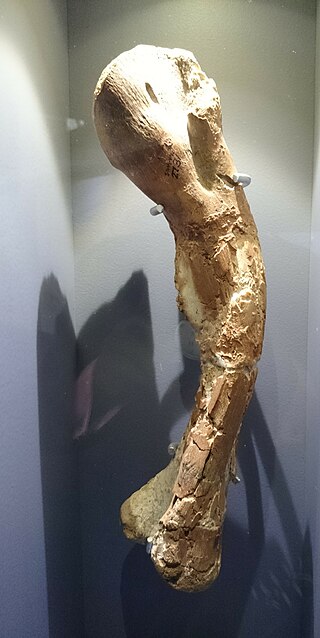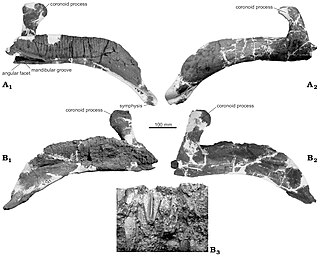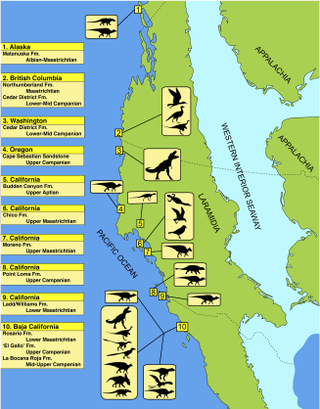Callovosaurus is a genus of iguanodontian dinosaur known from most of a left thigh bone discovered in Middle Jurassic-age rocks of England. At times, it has been considered dubious or a valid genus of basal iguanodontian, perhaps a dryosaurid.

Barsboldia is a genus of large hadrosaurid dinosaur from the early Maastrichtian Nemegt Formation of Ömnogöv', Mongolia. It is known from a partial vertebral column, partial pelvis, and some ribs.

Hypsibema is an extinct genus of hadrosaurid dinosaurs from the Late Cretaceous (Campanian-aged) Black Creek Group of North Carolina. The type species is H. crassicauda, with a potential second species in H. missouriensis.

Kangnasaurus is a genus of iguanodontian ornithopod dinosaur found in supposedly Early Cretaceous rocks of South Africa. It is known from a tooth and possibly some postcranial remains found in the early-Aptian Kalahari Deposits Formation. It was probably similar to Dryosaurus.
Microhadrosaurus is a genus of hadrosaurid dinosaur from the Campanian or Maastrichtian-age Upper Cretaceous Yuanpu Formation of Guangdong, China. Although its name identifies it as a small hadrosaur, it is based on juvenile remains, and the size of the adult hadrosaur is unknown.

Dryosauridae was a family of primitive iguanodonts, first proposed by Milner & Norman in 1984. They are known from Middle Jurassic to Early Cretaceous rocks of Africa, Europe, and North America.
The Cedar Mountain Formation is the name given to a distinctive sedimentary geologic formation in eastern Utah, spanning most of the early and mid-Cretaceous. The formation was named for Cedar Mountain in northern Emery County, Utah, where William Lee Stokes first studied the exposures in 1944.

Halszka Osmólska was a Polish paleontologist who had specialized in Mongolian dinosaurs.
The Twin Mountains Formation, also known as the Twin Mak Formation, is a sedimentary rock formation, within the Trinity Group, found in Texas of the United States of America. It is a terrestrial formation of Aptian age, and is notable for its dinosaur fossils. Dinosaurs from this formation include the large theropod Acrocanthosaurus, the sauropod Sauroposeidon, as well as the ornithopods Tenontosaurus and Convolosaurus. It is the lowermost unit of the lower Cretaceous, lying unconformably on Carboniferous strata. It is overlain by the Glen Rose Formation. It is the lateral equivalent of the lower part of the Antlers Formation.

Velafrons is a genus of lambeosaurine hadrosaurid dinosaur from the Late Cretaceous of Mexico. It is known from a mostly complete skull and partial skeleton of a juvenile individual, with a bony crest on the forehead. Its fossils were found in the late Campanian-age Cerro del Pueblo Formation, near Rincon Colorado, Coahuila, Mexico. The type specimen is CPC-59, and the type species is V. coahuilensis.

Sahaliyania is a genus of lambeosaurine hadrosaurid dinosaur from the Late Cretaceous of Heilongjiang, China.
The Suining Formation is a geological formation in China whose strata date back to the Early Cretaceous. Dinosaur remains are among the fossils that have been recovered from the formation. A 2019 paper shows zircon dating of the Suining Formation with a much younger age for the classically thought of Late Jurassic formation; the average age of the dating being roughly 114 myo or late upper Aptian. However, these results were subsequently challenged, with suggestions that the age of the zircons was affected by metamorphism, and that the zircons clustering around 145 Ma near the Jurassic Cretaceous boundary are closer to the correct date.
The Grès supérieurs Formation is a geological formation in Laos whose strata date back to the Aptian to Albian stages of the Early Cretaceous. Dinosaur remains are among the fossils that have been recovered from the formation. It is equivalent to the Khok Kruat Formation of Thailand.
The El Picacho Formation is a geological formation in Texas, United States, whose strata date back to the Late Cretaceous. Dinosaur remains are among the fossils that have been recovered from the formation. The paleosols found here are rich in clay, calcite, and rhizoliths which show that during the Cretaceous period, this fossil formation, just like the neighboring Javelina Formation and Aguja Formation, was a fluvial flood plain.

The Cape Sebastian Sandstone is a Mesozoic geologic formation in the state of Oregon in the United States. Hadrosaurid dinosaur remains, such as the sacrum of the Cape Sebastian ornithopod, are among the fossils that have been recovered from the formation, although none have yet been referred to a specific genus. The formation dates to the Campanian stage of the Late Cretaceous epoch.
The Lomas Coloradas Formation is a Mesozoic geologic formation in Mexico. Dinosaur remains are among the fossils that have been recovered from the formation, although only a few have yet been referred to a specific genus. Indetermiate hadrosaur remains and indeterminate sauropod remains, most likely belonging to Alamosaurus, have been unearthed here.
The Tongfosi Formation is a Late Cretaceous (Cenomanian) geologic formation of the Yanji Group in China. Fossil ornithopod tracks of iguanodontids and theropods have been reported from the fluvial sandstones of the formation.

Iguanacolossus is a genus of iguanodontian ornithopod dinosaur that lived in North America during the Early Cretaceous period. It is known from UMNH VP 20205, the associated holotype with a large partial skeleton of a single individual.
The Jingchuan Formation is a Barremian geologic formation in China. Various dinosaur fossils and tracks have been reported from the formation.
The Dabrazhin Formation preserves dinosaur fossils in Kazakhstan and Tajikistan. There are indeterminate remains of sauropods, nodosaurs, ornithomimosaurs, and other reptiles.

















